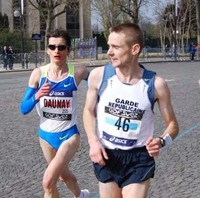
The interpretation of results of sideline vision tests for immediate signs of concussion may be confounded for athletes who speak English as a second language (ESL).
A new study from New York University (NYU) Medical Center’s Rusk Rehabilitation has revealed significantly lower test times for healthy participants for whom English is a second language, compared with native speakers. A computerised eye-tracking device also recorded a significantly higher number of saccades in the ESL group than in the native English-speaking group.
According to the researchers, these results might have important implications for use of vision testing to positively detect concussions on sidelines, and its increasing use at games and practices.
“These results highlight important disparities that language has on results of sideline vision testing, which are becoming more utilized in sports,” says study co-author Joel Birkemeier, a postdoctoral research fellow at NYU Langone’s Rusk Rehabilitation. “When performing sideline vision tests, clinicians and trainers may need to first take into account how language may affect score results.”
Preliminary research results were recently presented at the February 2016 annual meeting of the Association of Academic Physiatrists (AAP) Annual Meeting in Sacramento, California.
For the study, 54 people—27 native English speakers and 27 ESL speakers—were evaluated with a computerised version of the King-Devick (K-D) vision test. Patients ranged in age from 24 to 52 years old, with Spanish and Chinese being the most common native languages in the ESL group.
Previous research led by the NYU Langone Concussion Center has shown that the K-D test detects concussion 86% of the time among youth, collegiate, and professional athletes tested.
In this particular study, researchers utilised a novel, infrared-based eye-tracking device called the EyeLink. The Eyelink tracks eye movements while the participants look at a computer interface that contains the number sequences used in the K-D test. NYU Langone researchers are using this device to develop biomarkers for concussion and other neurological conditions.
The study participants also completed a Bilingual Dominance Scale survey, which measured how dominant they were in their primary, non-English language as opposed to their secondary, English language.
In addition to slower test times among the ESL group, the results showed that the “rest” time between saccadic eye movements was significantly longer for the ESL group compared to the native English speaking group. These results might be reflective of the time needed to process and say each number, according to the researchers. The total number of saccades for the ESL group was also significantly higher than the native English speaking group. Participants who were less dominant in their primary language, according to the survey, performed the vision tests quicker.
Future research will look closer at whether sideline vision testing in other languages influences results, as well as how other demographic characteristics affect the results of the test.
“Regardless of native language, if vision testing is performed properly where an athlete is tested before the season and after a suspected head injury, a drop in score should still suggest that he or she should be removed from play. In situations where baselines are not available, and scores are judged against average sideline test results, the comparisons become more precarious. We hope this initiates dialogue on multilingualism in sideline concussion screening,” says lead study author John-Ross Rizzo, assistant professor of rehabilitation medicine and neurology at NYU Langone and director of the Visuomotor Integration Laboratory at Rusk Rehabilitation. “Until the research answers these questions, the bottom line remains — when there’s any doubt if an athlete sustained a concussion during play, take the athlete out.”












